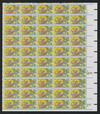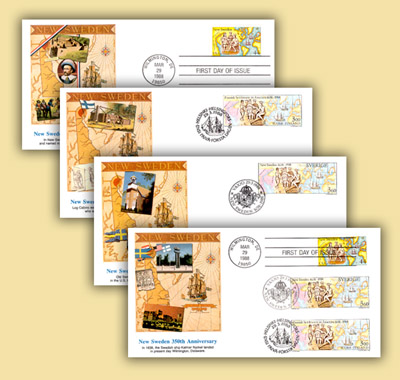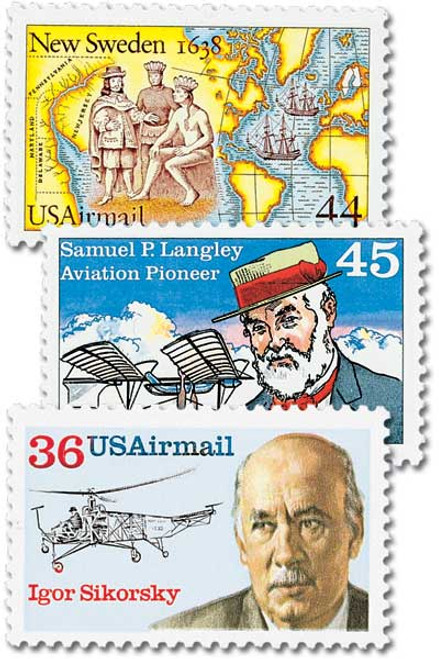
# C117 - 1988 Joint Issue w/Sweden Airmail
1988 44¢ Settling of New Sweden
First City: Wilmington, Delaware
Quantity Issued: 22,975,000
Printed by: Bureau of Engraving and Printing
Printing Method: Lithographed, engraved
Perforation: 11
Founding Of New Sweden
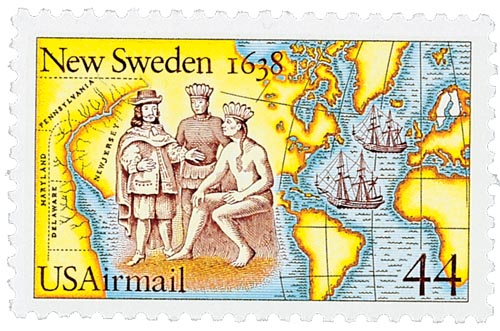
On March 29, 1638, the New Sweden Colony was established, encompassing parts of present-day Delaware, New Jersey, and Pennsylvania.
In the 1600s, Sweden was a significant world power, with possessions including Finland, parts of Poland, Latvia, Estonia, Lithuania, Germany, and the Soviet Union. After hearing of the success the British and Dutch had in North America, Sweden sought to expand its territorial holdings.
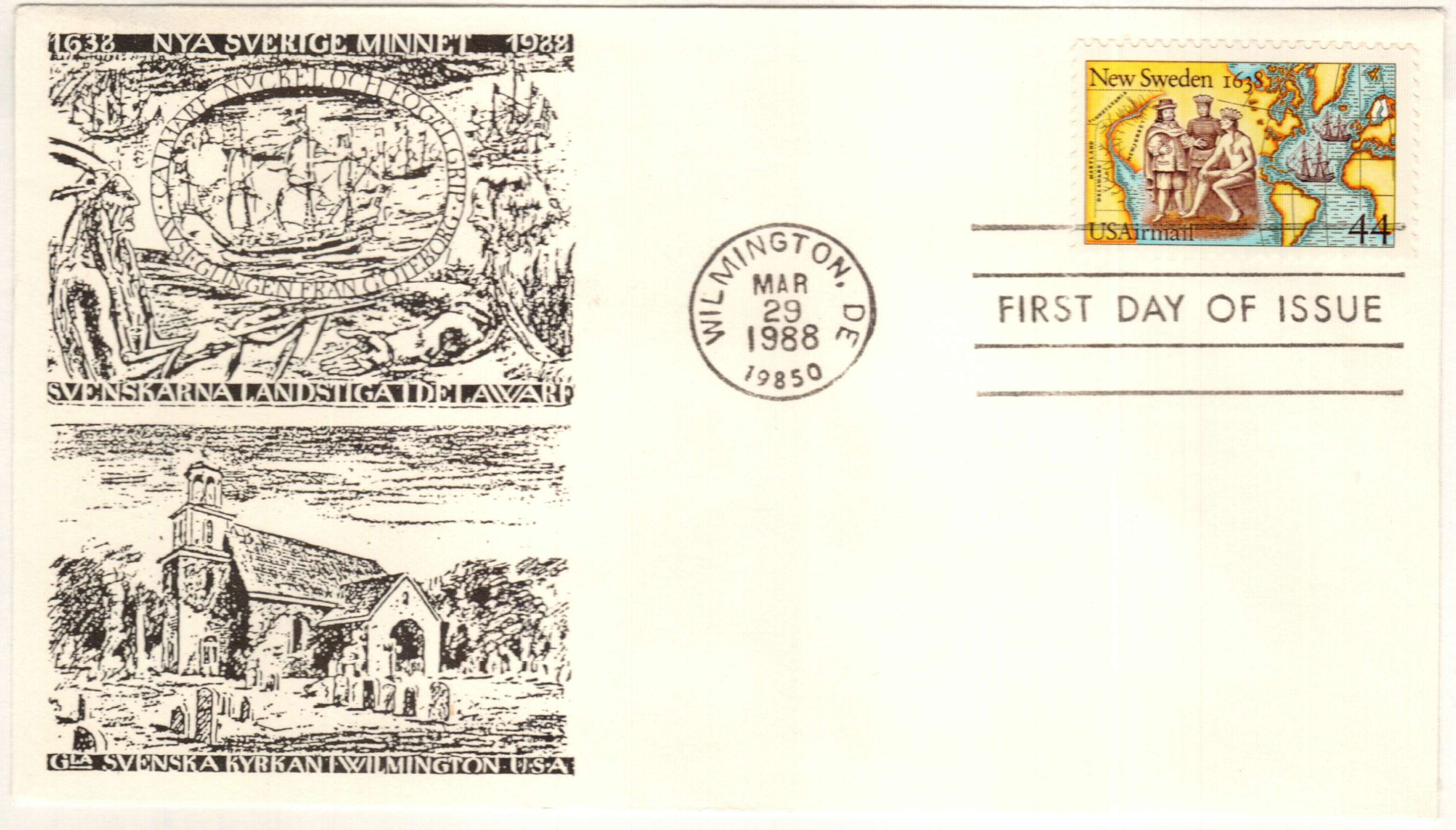
In 1637, a group of Swedish, Dutch, and German stockholders created the New Sweden Company to trade fur and tobacco. Later that year, Peter Minuit sailed the company’s first ship to North America. In March 1638, they reached the Minquas Kill (present-day Christina River) near today’s Wilmington. After coming ashore, Minuit met with the Lenape tribe and negotiated to buy land on the west riverbank of the Delaware River south of today’s Wilmington up to the Schuylkill River (south of present-day Philadelphia).
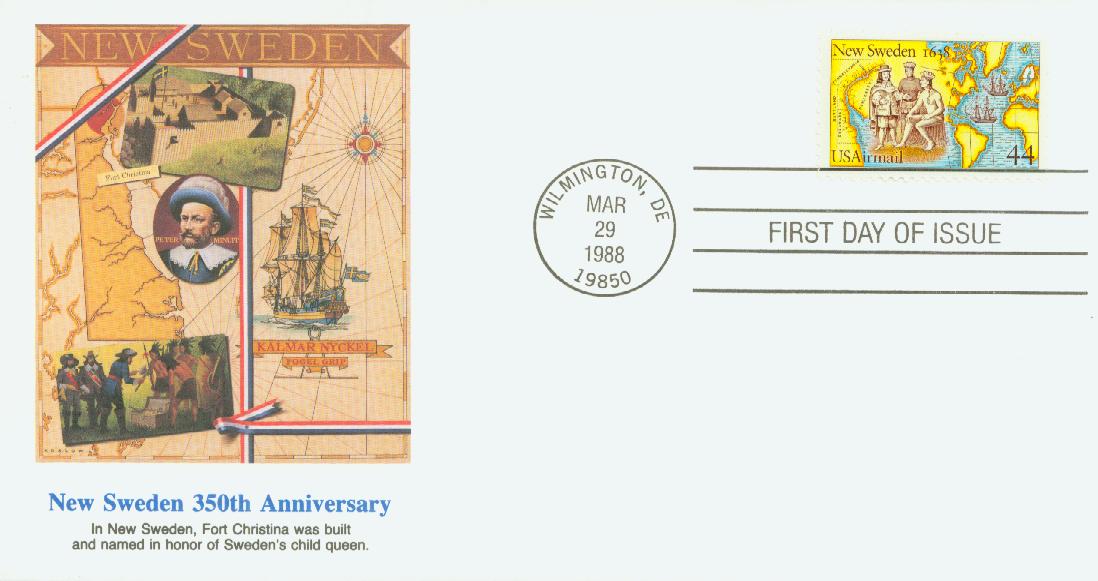
The purchase was completed on March 29, 1638, and Minuit declared the area the colony of New Sweden. Minuit ordered the construction of Fort Christina (named for the princess and future queen), the first permanent white settlement, at the present-day site of Wilmington. The colony quickly expanded northward as new colonists arrived from Sweden and Finland.
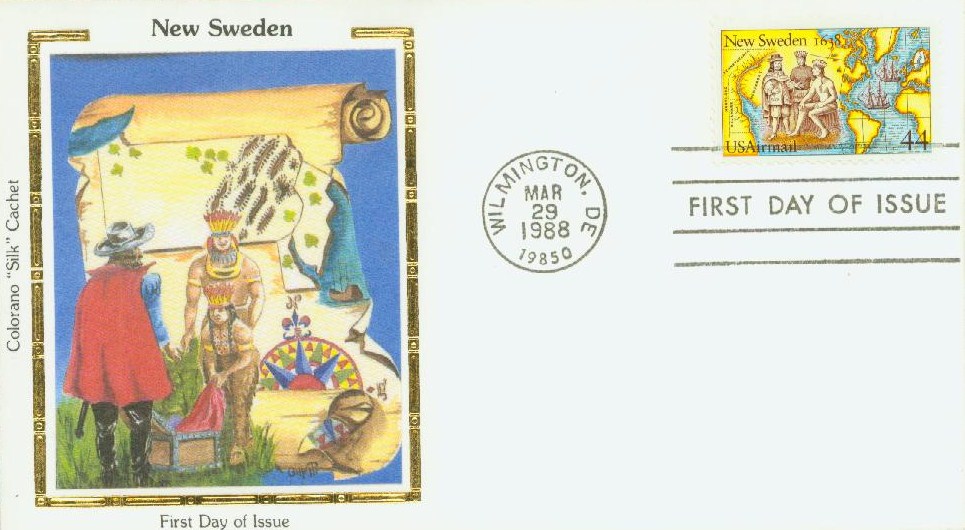
However, the Dutch believed New Sweden fell within their territory, and in 1651, the governor of the Dutch colony of New Netherland, Peter Stuyvesant, established Fort Casimir at the site of present-day New Castle. The Swedes captured Fort Casimir in 1654, but the following year the Dutch took control of New Sweden. Most of the Swedish settlers remained, and lived in peace under Dutch rule.
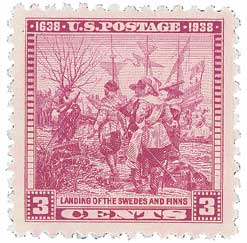
In 1938, the US, Sweden, and Finland each issued stamps honoring the New Sweden colony. The US issued its red-violet “Landing of the Swedes and Finns” stamp, while Finland issued one stamp and Sweden issued a set of seven stamps with five different designs. To mark the 300th anniversary, Swedish crown prince Gustav Adolf visited the United States and unveiled a monument at Wilmington with President Franklin Roosevelt.
Fifty years later, the three nations would each honor this event once again on their stamps, but this time, as part of a joint-issue. It was the third joint-issue between the US and Sweden and the first between the US and Finland. It was, however, the first time the US created a joint-issue with two countries at once.
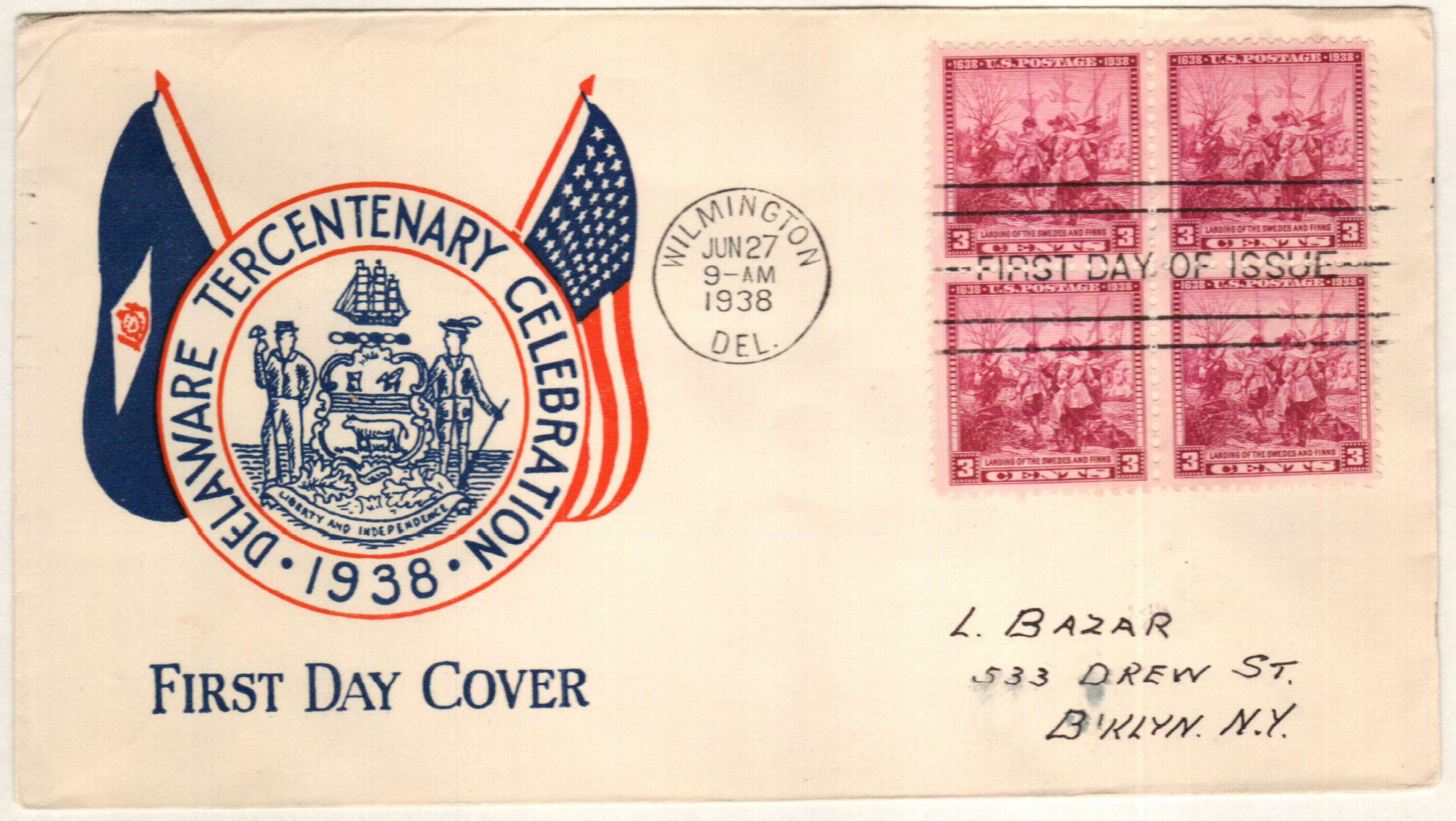
The stamps were issued on March 29, 1988, in cities in all three countries. In the US, the ceremonies were held at Wilmington’s Grand Opera House. The Sweden ceremony was held in Vaxjo and the Finland ceremony in Helsinki.
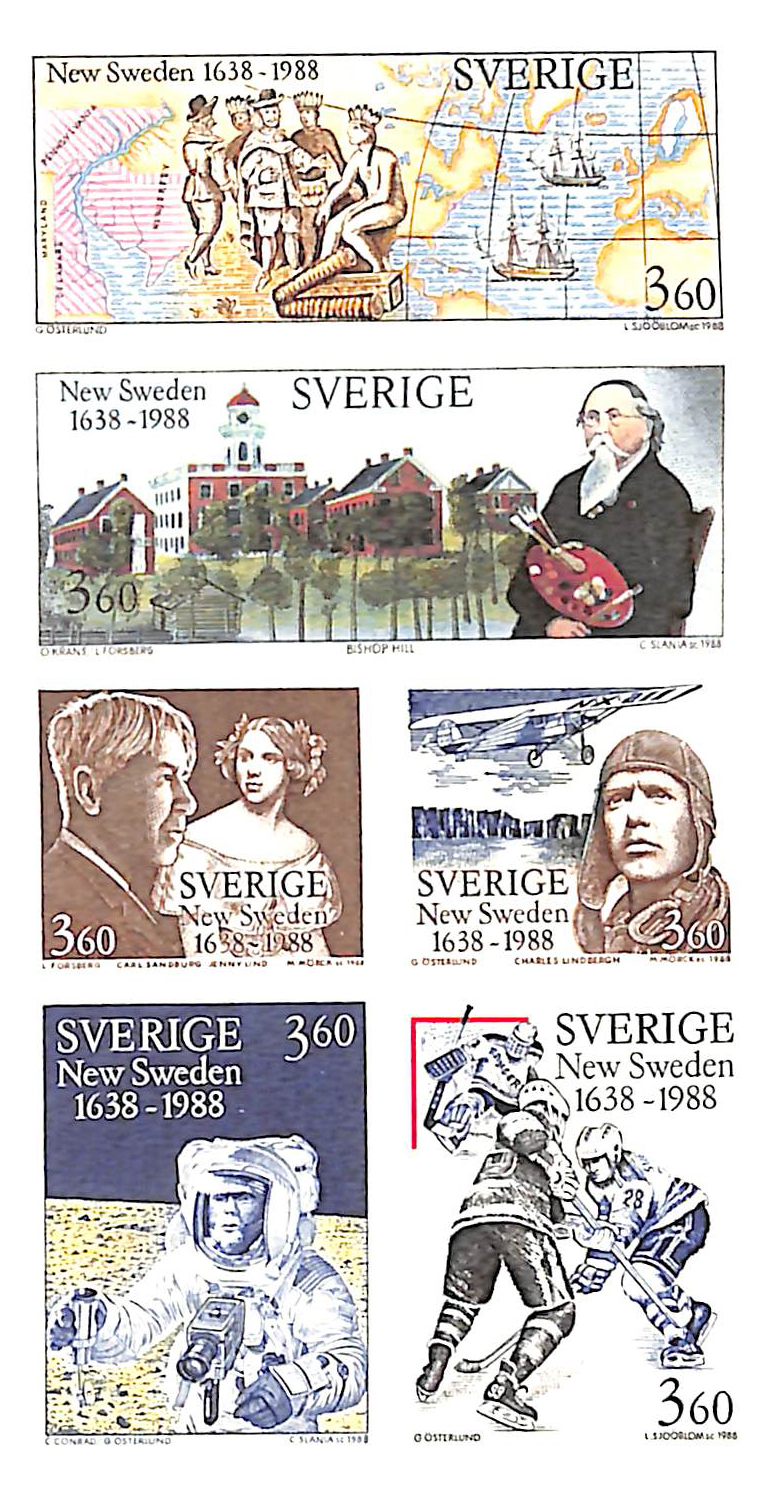
Another interesting aspect of the US stamp is that it became obsolete faster than any previous US stamp. The 44¢ stamp covered the international airmail rate for just five days before the rate was raised to 45¢. Because of the massive planning that went into the three-nation joint-issue, they didn’t have time to change the stamp’s denomination and couldn’t delay its issue. The stamp was removed from sale just seven months after its issue, making it one of the shortest sale periods up to that time.
1988 44¢ Settling of New Sweden
First City: Wilmington, Delaware
Quantity Issued: 22,975,000
Printed by: Bureau of Engraving and Printing
Printing Method: Lithographed, engraved
Perforation: 11
Founding Of New Sweden

On March 29, 1638, the New Sweden Colony was established, encompassing parts of present-day Delaware, New Jersey, and Pennsylvania.
In the 1600s, Sweden was a significant world power, with possessions including Finland, parts of Poland, Latvia, Estonia, Lithuania, Germany, and the Soviet Union. After hearing of the success the British and Dutch had in North America, Sweden sought to expand its territorial holdings.

In 1637, a group of Swedish, Dutch, and German stockholders created the New Sweden Company to trade fur and tobacco. Later that year, Peter Minuit sailed the company’s first ship to North America. In March 1638, they reached the Minquas Kill (present-day Christina River) near today’s Wilmington. After coming ashore, Minuit met with the Lenape tribe and negotiated to buy land on the west riverbank of the Delaware River south of today’s Wilmington up to the Schuylkill River (south of present-day Philadelphia).

The purchase was completed on March 29, 1638, and Minuit declared the area the colony of New Sweden. Minuit ordered the construction of Fort Christina (named for the princess and future queen), the first permanent white settlement, at the present-day site of Wilmington. The colony quickly expanded northward as new colonists arrived from Sweden and Finland.

However, the Dutch believed New Sweden fell within their territory, and in 1651, the governor of the Dutch colony of New Netherland, Peter Stuyvesant, established Fort Casimir at the site of present-day New Castle. The Swedes captured Fort Casimir in 1654, but the following year the Dutch took control of New Sweden. Most of the Swedish settlers remained, and lived in peace under Dutch rule.

In 1938, the US, Sweden, and Finland each issued stamps honoring the New Sweden colony. The US issued its red-violet “Landing of the Swedes and Finns” stamp, while Finland issued one stamp and Sweden issued a set of seven stamps with five different designs. To mark the 300th anniversary, Swedish crown prince Gustav Adolf visited the United States and unveiled a monument at Wilmington with President Franklin Roosevelt.
Fifty years later, the three nations would each honor this event once again on their stamps, but this time, as part of a joint-issue. It was the third joint-issue between the US and Sweden and the first between the US and Finland. It was, however, the first time the US created a joint-issue with two countries at once.

The stamps were issued on March 29, 1988, in cities in all three countries. In the US, the ceremonies were held at Wilmington’s Grand Opera House. The Sweden ceremony was held in Vaxjo and the Finland ceremony in Helsinki.

Another interesting aspect of the US stamp is that it became obsolete faster than any previous US stamp. The 44¢ stamp covered the international airmail rate for just five days before the rate was raised to 45¢. Because of the massive planning that went into the three-nation joint-issue, they didn’t have time to change the stamp’s denomination and couldn’t delay its issue. The stamp was removed from sale just seven months after its issue, making it one of the shortest sale periods up to that time.







